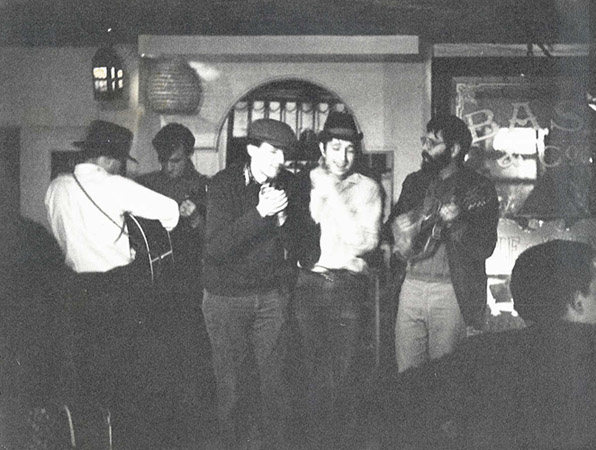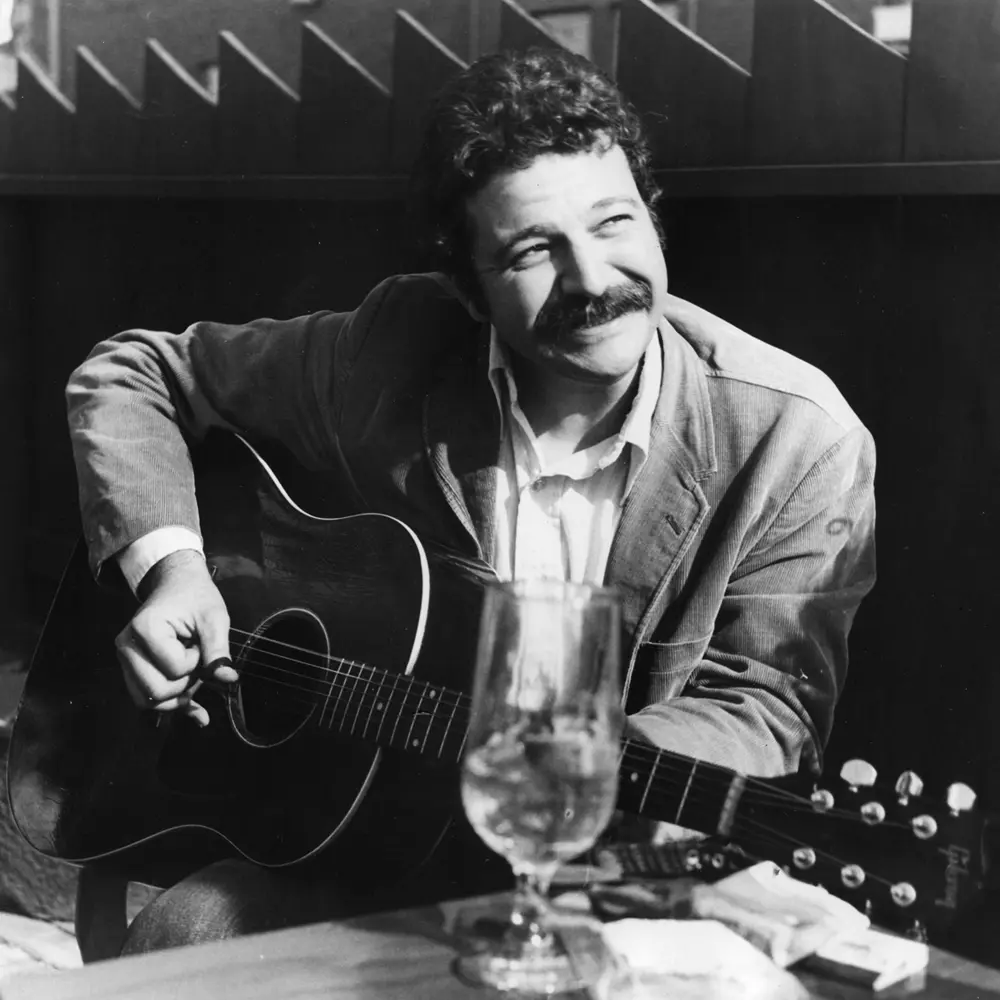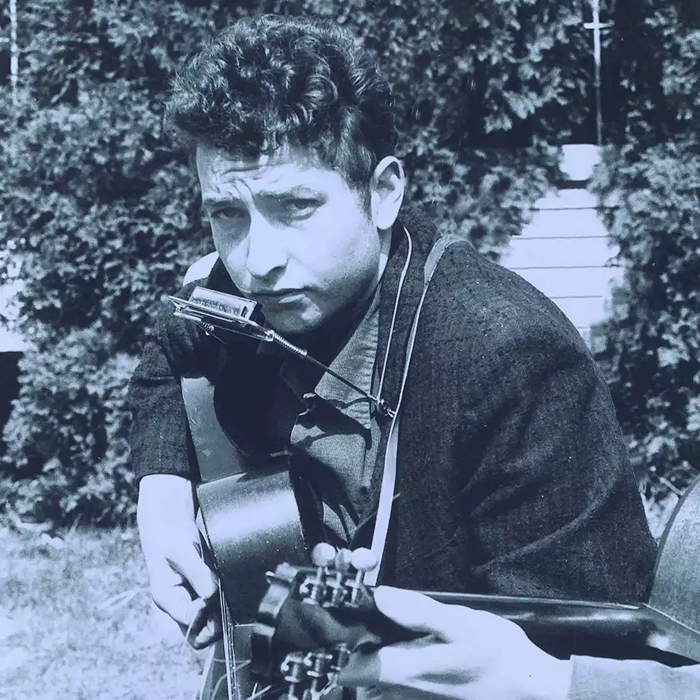Eric von Schmidt

It’s impossible to overstate Eric von Schmidt’s prominence in the Cambridge folk scene during the late ‘50s and ‘60s or the scope of his influence on other folk musicians across New England and beyond. Aside from his obvious gifts as a singer, songwriter, guitarist, banjo player, illustrator and painter, he was widely viewed as among New England’s leading folk-blues scholars and his legacy has reverberated through decades like that of few others.
In terms of respect from his musical contemporaries and the folk community as a whole, in the liner notes for von Schmidt’s 1969 album Who Knocked the Brains Out of the Sky?, Bob Dylan summarized him in a way that reminded many of the era of Muhammad Ali’s rhyming rants: “For here is a man who can sing the bird off the wire and the rubber off the tire. He can separate the men from the boys and the note from the noise. The bridle from the saddle and the cow from the cattle. He can play the tune of the moon. The why of the sky and the commotion from the ocean. Yes he can.”
Musical beginnings
Born in Bridgeport, Connecticut, on May 28, 1931, von Schmidt began drawing and painting as a young boy, inspired by his father, who was an illustrator for the Saturday Evening Post. The younger von Schmidt started selling his own paintings before he entered the 10th grade.
He said he was inspired to learn guitar after hearing Leadbelly’s rendition of “Good Night, Irene” on the radio at age 13. When he was in high school, he often went to New York City to watch folk artists playing in tiny clubs and coffee shops, eventually befriending Greenwich Village folk icon Ramblin’ Jack Elliot, who helped land the 16-year old von Schmidt his radio debut (where he played one song, the traditional murder ballad “Pretty Polly,” on banjo). “Eric’s got that wild spirit,” Elliot told The Boston Globe in 1996. “And he doesn’t water the music down for polite society.”
Art studies, Military service, Move to Cambridge
After graduating from high school, von Schmidt studied art in Florence, Italy, on a Fulbright scholarship before spending two years in the Army, stationed in Washington DC. While enlisted, he passed countless hours at the Library of Congress researching traditional songs in the archives of the Folklore Department, often molding them into his own renditions.
In 1957, he moved to Cambridge, where he lived across the street from Tulla’s Coffee Grinder, which had opened in late 1956 and became one of Harvard Square’s most iconic spots. The local folk scene gained substantial momentum in 1958, when Joan Baez debuted in the city and Club Mount Auburn 47 opened, and snowballed through mid-‘60s as singer-songwriters such as Tom Rush, Geoff Muldaur, Jim Kweskin, Jackie Washington, Mitch Greenhill, Buffy Sainte-Marie, Taj Mahal and Ramblin’ Jack began playing frequently in the area.
Notable appearances
By early 1960, von Schmidt had become a defining figure on the Cambridge folk scene and he was one of the most frequent acts at Club 47 for the better part of the decade. In May 1960, he appeared at the Indian Neck Folk Festival in Connecticut on a bill with Joan Baez, The Highwaymen, Jackie Washington and others and in 1961 he played the festival again along with Baez, Kweskin and 19-year-old Dylan, among others. Von Schmidt debuted at the Newport Folk Festival in July 1965 – the year Dylan famously “went electric” to the horror and disgust of countless folkies – and at Boston’s Symphony Hall in December 1966.
Albums, Album-cover art, Grammy award
In 1961, he recorded his debut album, partnering with Rolf Cahn (Rolf Cahn & Eric Von Schmidt, Folkways). His sophomore LP was also a collaboration, Dick Fariña & Eric Von Schmidt (Folklore, 1963), recorded at Dobell’s Jazz Record Shop in London with Dylan on harmonica (credited as “Blind Boy Grunt”).
Von Schmidt cut three more LPs in the ‘60s: The Folk Blues of Eric von Schmidt (Prestige/Folklore, 1964), Eric Sings Von Schmidt (Prestige, 1965) and Who Knocked the Brains Out of the Sky? (Smash, 1969). In the ‘70s, he recorded just two LPs, 2nd Right, 3rd Row (1972, Poppy) and Eric Von Schmidt & the Cruel Family (Philo, 1977). During most of the ‘80s and early ‘90s he focused on painting and drawing and his final studio outings were Baby Let Me Lay It On You (Gazell, 1995) and Living on the Trail (Tomato, 2002). His material has been included on over a dozen compilation albums.
In 1997, von Schmidt won a Grammy for Best Album Notes for the 84-track Anthology of American Folk Music compilation, issued by Smithsonian Folkways. In addition to painting the covers for his own albums, von Schmidt also did so for discs by Joan Baez, Cicco Houston, Paul Geremia, John Renborn, Geoff Muldaur, Maria Muldaur, Jackie Washington and Reverend Gary Davis.
“Baby, Let Me Follow You Down”
A walking encyclopedia of folk and folk-blues, von Schmidt was famous for his uniquely updated renditions of standards and for taking great care to highlight the regional origins of those songs and the actual writer(s). The glaring irony is that he did not actually write the song for which he’s most often credited, “Baby, Let Me Follow You Down.”
As he was quick to point out, he adapted the tune from one by blues great Blind Boy Fuller that he first heard played by singer-songwriter Hugh Quin “Geno” Forman; von Schmidt once said that blues/gospel singer Reverend Gary Davis was the author of “three quarters of ” his arrangement. In 1979, when he co-authored a book on the Cambridge folk scene with Americana singer-songwriter-producer Jim Rooney, its title, Baby, Let Me Follow You Down: The Illustrated Story of the Cambridge Folk Years, was something of an inside joke.
Dylan, von Schmidt’s junior by almost exactly 10 years, included the track on his self-titled debut album in 1962 – credited as “Traditional arranged by Eric von Schmidt” – and made it a staple of his setlist until the mid-‘60s. According to von Schmidt’s obituary in The New York Times, the elder singer-songwriter taught Dylan the tune during one of his visits to Cambridge in late 1961.
“I sang him a bunch of songs and, with that spongelike mind of his, he remembered almost all of them when he got back to New York,” he told The Boston Globe in 1996. Over the guitar introduction on his debut LP, Dylan says he “first heard this song by Rick von Schmidt,” adding he “met him one day in the green pastures of Harvard University.”
Death, Legacy
On February 2, 2007, von Schmidt died in his sleep in Fairfield, Connecticut, at age 75. He’d been diagnosed with throat cancer in 2000 and suffered a stroke in August 2006, but the actual cause of death was undetermined, his daughter Caitlin von Schmidt told The Hollywood Reporter.
“Harvard Square was a center of the rebirth of folk music in America in the late 1950s and 1960s,” read a lengthy obituary in The Boston Globe, “and Eric von Schmidt was its raffish, raspy, bearded midwife.”
(by D.S. Monahan)
















